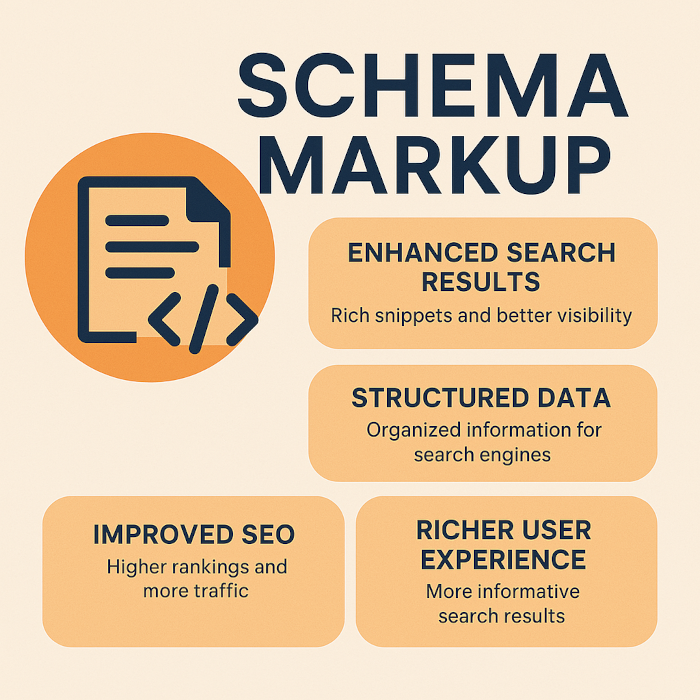What is a Schema Markup?
Schema markup is your website's secret weapon for standing out in search results. Learn how this invisible code can transform your SEO strategy and significantly boost click-through-rates (CTR) on your site.
Schema markup is like giving search engines a cheat sheet about your webpage.
It’s code that you add to your website to help search engines understand your content better. Think of it like giving Google a cheat sheet to what’s on your page. It can boost your visibility with rich results, like:
- Star Ratings
- Event Dates
- Business Info
- Product Details
A Real-Life Example
Imagine you're at a crowded party trying to explain what you do for work. You could ramble on for 20 minutes, hoping the important bits stick... or you could hand over your business card with all the key info clearly displayed.
Schema markup is that business card for your website.
It's invisible code added to your site that tells Google and other search engines exactly what your content is about - not just what it says. Think of it as whispering directly to Google: "Hey, this isn't just text about cooking times... this is an actual RECIPE with prep time, ingredients, and ratings!"
Without schema, search engines make educated guesses about your content. With schema, you're literally spelling it out for them.
The payoff? Rich results in search listings: those eye-catching recipe cards with star ratings, product listings with prices, event details with dates, and so on. Your listing stands out, takes up more real estate on the results page, and gives people exactly what they're looking for before they even click.
It's like upgrading from "I sell stuff online" to handing someone a mini-catalog of your best products, complete with prices and reviews.
Why Schema Markup Matters for SEO
- Improved Search Visibility: Rich snippets make your content stand out in search results.
- Higher Click-Through Rates (CTR): Eye-catching details like reviews and pricing encourage more clicks.
Better User Experience (UX): Users can quickly access key information directly from search results

The Technicals....
Types of Schema Markup
Some commonly used schema types include:
- Organization Markup: Displays business details like name, logo, and contact info.
- Product Markup: Highlights product details such as ratings, reviews, and availability.
- Article Markup: Enhances blog posts or news articles with metadata like author and publication date.
Formats for Implementing Schema
Google supports three main schema formats:
- JSON-LD: A JavaScript-based format recommended by Google for its simplicity and ease of maintenance.
- Microdata: Embeds structured data directly into HTML elements.
- RDFa: Uses HTML attributes to define relationships within the content123.
How to Add a Schema Markup
- Use tools like Google’s Structured Data Markup Helper to generate schema code.
- Add the generated schema to your website's HTML, preferably using JSON-LD for simplicity.
- Test your implementation with tools like Google’s Rich Results Test to ensure accuracy
While schema markup doesn’t guarantee rich results, it significantly improves the chances of enhanced visibility and engagement in search engines.
Get a Free Step-by-Step Guide
If you feel like you’re ready to take a stab at it and add the schema markups yourself then type this prompt into chatGPT or your LLM of choice to get step-by-step instructions.
"Act as an expert in technical SEO and web development. Provide a detailed, step-by-step guide on how to add schema markup to a website. The guide should include both manual implementation using HTML and JSON-LD, as well as how to apply schema using popular platforms like WordPress.
Explain how to select the correct schema type for different types of content, how to validate the markup using tools like Google's Rich Results Test or Schema.org Validator, and how to monitor its performance in Google Search Console. Include practical examples and beginner-friendly instructions throughout the process."
If You Get Stuck....
If you get to the point to where you tried and you’re ready to throw your computer out the window or set an active grenade on it, then please give us a jingle. We love to nerd out on stuff like this!
Continue reading.
The Element API plugin is a very powerful tool that you can use for quickly exposing your data structures to an external source.
Read moreA brief introduction to consensus mechanisms and why proof of stake is the right move for Ethereum.
Read moreLet's chat about your project
Portland, OR 97215



